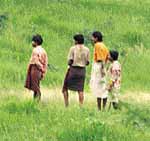A tale of two districts
 In 1985, both Kalahandi in Orissa and Jhabua in Madhya Pradesh came into the limelight. This followed reports of children being sold in Kalahandi and food riots in Jhabua.Both these problems were related to the ecology.
In 1985, both Kalahandi in Orissa and Jhabua in Madhya Pradesh came into the limelight. This followed reports of children being sold in Kalahandi and food riots in Jhabua.Both these problems were related to the ecology.
More than a decade later, Jhabua's ecology has regenerated through a government-sponsored but people-managed watershed development programme, while Kalahandi has slid further into the abyss of eco-destruction.
Like Jhabua, Kalahandi is a tribal upland. In 1990, the forest cover was 67 per cent. Every village in the region has a network of tanks built in the late 18th and early 19th century. But mindless deforestation and destruction of water tanks has resulted in the
per hectare (ha) in Kalahandi. According to official estimates, the district loses Rs 8,000 crore annually due to soil erosion. The soil conservation department has spent more than Rs 90 crore in the last 14 years to build 1,400 water-harvesting structures. The construction of 58 micro-watersheds (of 500 ha each) with an investment of Rs 14.5 crore is also in progress.
"But without effective people's participation... these programmes have not been able to bring eco-regeneration and improvement in the socioeconomic condition of the people,' says the State of Orissa's Environment , published by the Council of Professional Social Workers.
In Madhya Pradesh, the government has created many institutions at the state, district and village levels to initiate a people's movement for watershed development. In Orissa, there has been no such initiative.
Related Content
- Action plan on behalf of the Deputy Commissioner, Bangalore Urban District on pollution of Chandrapura lake, 01/08/2022
- Order of the National Green Tribunal regarding Chandrapura lake pollution, Bangalore, Karnataka, 29/03/2022
- Order of the National Green Tribunal regarding mining by M/s Jindal Saw Ltd., Bhilwada, Rajasthan, 12/10/2020
- Evaluation of iron and manganese ion levels from Manar dam of Barul, Maharashtra
- Uranium in groundwater: lack of a prescribed limit confusing the public (editorial)
- 24 deaths in 2 months
